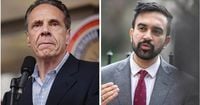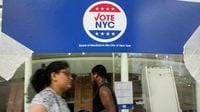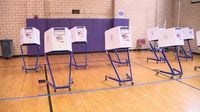New Yorkers headed to the polls on June 24, 2025, to decide the Democratic nominee for mayor in a high-stakes race that has captivated the city’s political landscape. This election is not just any primary—it’s a showdown between former Governor Andrew Cuomo, a figure with a complicated legacy, and State Assemblyman Zohran Mamdani, a youthful progressive who has surged in popularity. With New York City employing ranked choice voting for the second time in a mayoral primary, the process promises to be both intricate and pivotal.
The ranked choice voting system allows voters to rank up to five candidates in order of preference. If no candidate secures more than 50% of first-choice votes, the candidate with the fewest votes is eliminated, and their votes are redistributed based on the voters’ next preferences. This elimination and redistribution continue until one candidate surpasses the 50% threshold. With 11 Democratic candidates on the ballot, including notable figures like City Comptroller Brad Lander and City Council Speaker Adrienne Adams, the method ensures that the eventual winner has broad support.
Polls opened at 6 a.m. and closed at 9 p.m. on June 24, with early voting already having seen a remarkable turnout—384,338 voters, more than double the early votes in 2021. This surge particularly favored Mamdani, who has energized younger voters and progressive communities across Brooklyn and Queens. Early voting results suggested Mamdani held a ten-point lead over Cuomo among early voters, signaling a potential shift in the city’s political dynamics.
Andrew Cuomo’s candidacy marks a comeback after his resignation in 2021 amid allegations of sexual harassment involving 13 women. Despite the controversy, Cuomo has maintained a strong base, especially among older, traditional Democratic voters in the Bronx and among Black and Latino communities. Cuomo’s campaign emphasizes law and order, pledging to hire 5,000 new police officers as part of a "five-borough crime and affordability plan." He has also campaigned vigorously on combating antisemitism and defending Israel, courting the Jewish vote, particularly among Orthodox Jews.
Zohran Mamdani, 33, born in Uganda and a member of the New York State Assembly, has emerged as the progressive alternative. His platform includes rent freezes for tenants in rent-stabilized apartments, expanded free childcare, and free public transportation. To fund these initiatives, Mamdani proposes a 2% tax increase on millionaires and a 4.5% hike on corporations. His campaign has thrived on social media engagement, small-dollar donations, and a volunteer force of approximately 20,000, largely younger voters. Endorsements from progressive icons like Congresswoman Alexandria Ocasio-Cortez and Senator Bernie Sanders have further solidified his appeal.
The race has been marked by strategic cross-endorsements. Brad Lander, the city comptroller who was arrested on June 17 while attempting to shield a migrant from ICE agents, and former Assemblyman Michael Blake endorsed Mamdani in the race’s final weeks to counter Cuomo’s momentum. City Council Speaker Adrienne Adams, though not endorsing Mamdani, urged her supporters to back the Working Families Party slate, effectively sidelining Cuomo. This coalition-building could prove decisive in the ranked choice tabulations.
Cuomo, meanwhile, has garnered support from influential figures such as former President Bill Clinton and former Mayor Michael Bloomberg, who has contributed over $8 million to a super PAC backing Cuomo. Despite this, campaign strategist Bill Knapp of the pro-Cuomo group Fix the City acknowledged that their voters tend to cast ballots on Primary Day rather than early, which could impact initial tallies.
The ranked choice voting process means that immediate results on election night may not reveal a clear winner. While first-choice votes will be tallied shortly after polls close, the full ranked choice tabulation will begin on July 1, after the city receives and counts all absentee, mail-in, and affidavit ballots. The final certification of results is expected by July 15. This delay is crucial in a tight race where second, third, and even fourth preferences could tip the balance.
Incumbent Mayor Eric Adams, who is not participating in the Democratic primary, is running for re-election as an independent. His tenure has been marked by a focus on public safety, with the city recording its lowest murder and shooting rates in decades during the first five months of 2025. However, Adams’s approval ratings have plummeted to a 30-year low of 20%, amid concerns over honesty and his approach to immigration issues. Adams’s independent candidacy adds another layer of complexity to the November general election.
On the Republican side, Curtis Sliwa, founder of the Guardian Angels, is the sole candidate. He has campaigned on reducing crime and addressing homelessness, criticizing Adams’s handling of the migrant crisis and advocating prioritization of city residents’ needs.
Housing affordability remains a critical issue for voters. With median rents climbing to $3,397 in April 2025—a 7% increase over the previous year—candidates have proposed various solutions. Mamdani’s rent freeze and Cuomo’s strategies to seize dilapidated buildings and offer tax incentives to developers highlight contrasting approaches to this challenge.
The Democratic primary also features races for public advocate, comptroller, borough presidents, and 32 City Council districts. Notably, former U.S. Representative Anthony Weiner attempts a political comeback in the City Council District 2 primary, despite his past scandals.
As New Yorkers await the unfolding of ranked choice tabulations in the weeks ahead, the mayoral race stands as a defining moment for the city’s political future. Will the seasoned, albeit controversial, Cuomo reclaim his former stature, or will Mamdani’s progressive wave reshape New York’s leadership? Regardless of the outcome, the election underscores a city grappling with its identity amid evolving demographics, political ideologies, and pressing urban challenges.






